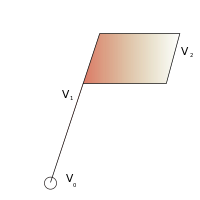Flag (math)
In linear algebra, a flag is a sequence of vector spaces of increasing dimensions with a real subset relationship. The name comes from the fact that the first three vector spaces - point, straight line, plane - can be arranged like an ordinary flag.
definition
A flag in a (mostly finite-dimensional) vector space over a body is a finite sequence of sub-vector spaces of with and , so that each sub-space is genuinely contained in the following, i.e. H.
Is or equivalent for , one speaks of a complete flag. Some authors only deal with complete flags and then speak of flags per se.
Examples
If there is a base of , it is through
defines a full flag. However, the date of the flag is weaker, different bases can produce the same flag.
Type of flags
Are and two flags that consist of the same number of subspaces and for the
- For
holds, it is said that and are of the same type. The types of flags are determined by the partitions of the number . Two flags of the same type will always be an automorphism of produce apart.
use
Is an endomorphism of , and holds
- for all
so the flag is called under invariant or stable . If the flag is complete, the existence of an invariant flag implies that there is a base of , which is represented by an upper triangular matrix ( trigonalization ). For more general flags, the result is a block triangular shape, which is determined by the type of flag.
Related terms
- The set of all automorphisms of that stabilize a given flag forms a parabolic subgroup of .
- The set of all flags of one type is called the flag manifold . Since it operates transitively on the set of all flags of a type , flag manifolds can be represented as homogeneous spaces of .
literature
- Gerd Fischer: Lineare Algebra , Vieweg-Verlag, ISBN 3-528-97217-3 .
- IR Shafarevich , AO Remizov: Linear Algebra and Geometry . Springer , 2012, ISBN 978-3-642-30993-9 .





















